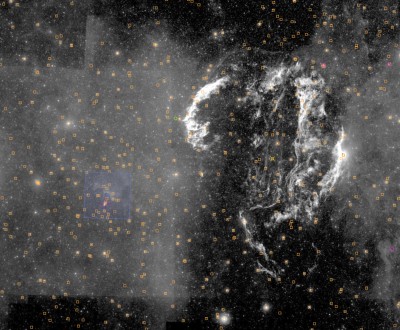ngc7013
Commentaires sur l’objet photographié
Données techniques
Commentaires sur l’objet photographié

La galaxie NGC7013 est située juste à coté des cébèbres dentelles du Cygne, bizarre que cette galaxie soit aussi peu photographiée alors que l’ensemble avec cette nébuleuse diffuse qui emet uniquement en luminance, la souce HII est nulle !
L’ensemble est magnifique et je n’ai pas trouvé de nom à cette nébuleuse diffuse autour de la galaxie.
Voici une vue générale de la galaxie à coté des dentelles.
source wikipedia
NGC 7013 is a relatively nearby spiral or lenticular galaxy[2][3] estimated to be around 37 to 41.4 million light-years away from Earth[4][5] in the constellation of Cygnus.[6] NGC 7013 was discovered by English astronomer William Herschel on July 17, 1784 and was also observed by his son, astronomer John Herschel on September 15, 1828.[7]
Physical characteristics
NGC 7013 is tilted 90° to the Earth’s line of sight,[8] allowing its structure to be seen. However, NGC 7013 is classified as either as a spiral galaxy with tightly wound arms or as a lenticular galaxy.[2][9] NGC 7013 is also considered part of a class of galactic nuclei that is defined by their spectral line emissions, called low-ionization nuclear emission-line region galaxies or LINERs.[9][10] The galaxy appears to have two rings in its structure. The inner ring appears to completely disconnect from the central bulge while the stars in the outer ring appear to have very little spiral pattern.[2] Optical images of NGC 7013 show that it has a small bulge[11] with a bright inner ring and a faint disk both crossed by dust lanes.[3] A longer exposure of the galaxy made by the Palomar Observatory-National Geographic Sky Survey shows an extended disk around the bulge and the inner ring. The disk shows little structure except for a faint, thin spiral-like feature running through the galaxy.[3]
HI distribution
The neutral atomic hydrogen distribution in NGC 7013 is mostly located in the two rings. In between the two rings there is a very low concentration of interstellar medium. The low level of neutral atomic hydrogen in the disk of NGC 7013 and the reddish color of the galaxy suggests that the gas content of the galactic disc has fallen below the threshold at which star formation is likely to take place. The small bulge-to-disk ratio and the slow rotation velocity show that NGC 7013 is a low-mass, low-density galaxy unlike the more luminous, typical lenticular galaxies. The galaxy may thus be a former late-type spiral galaxy which have exhausted most of its interstellar gas, either by star formation or by internal sweeping.[3]


